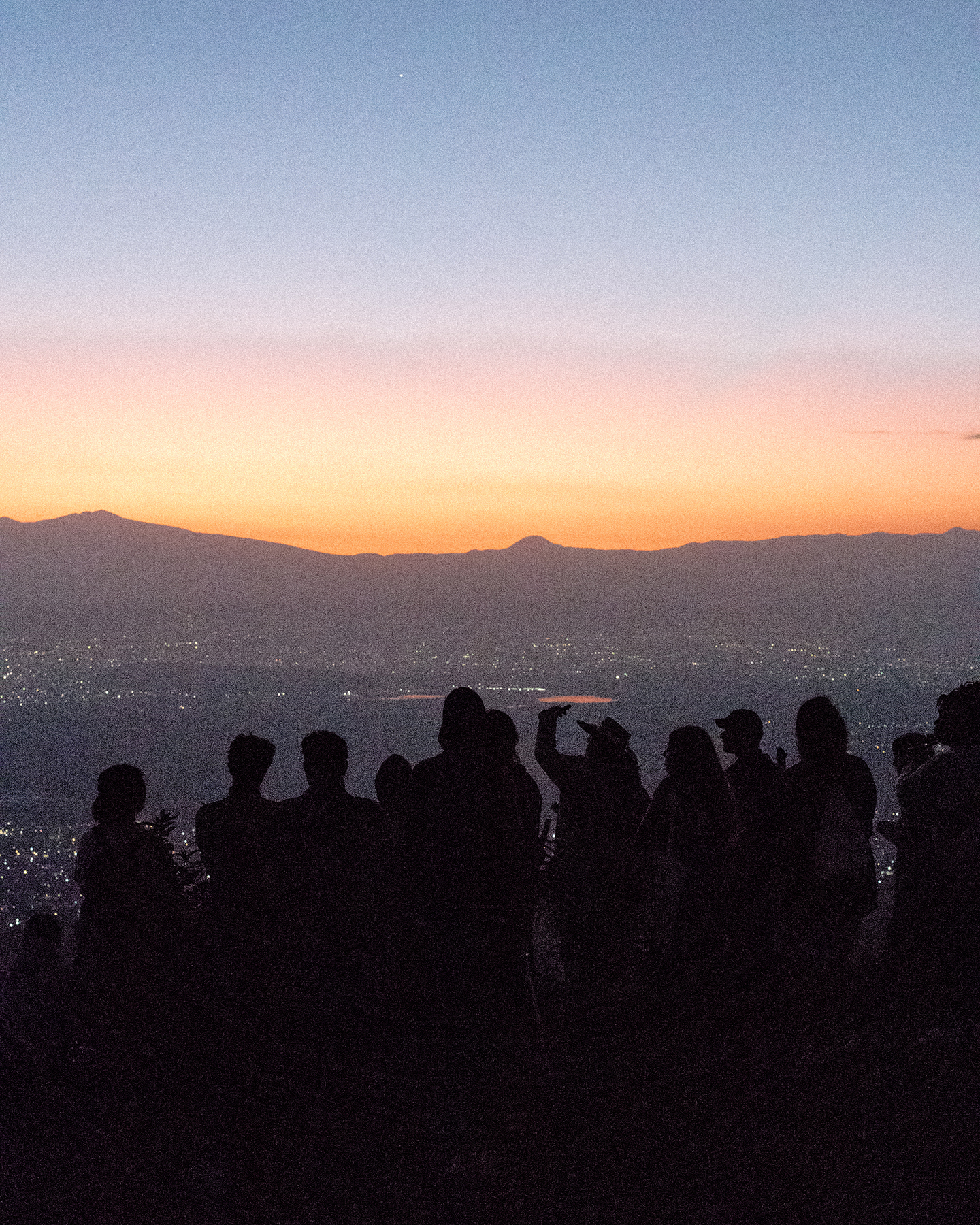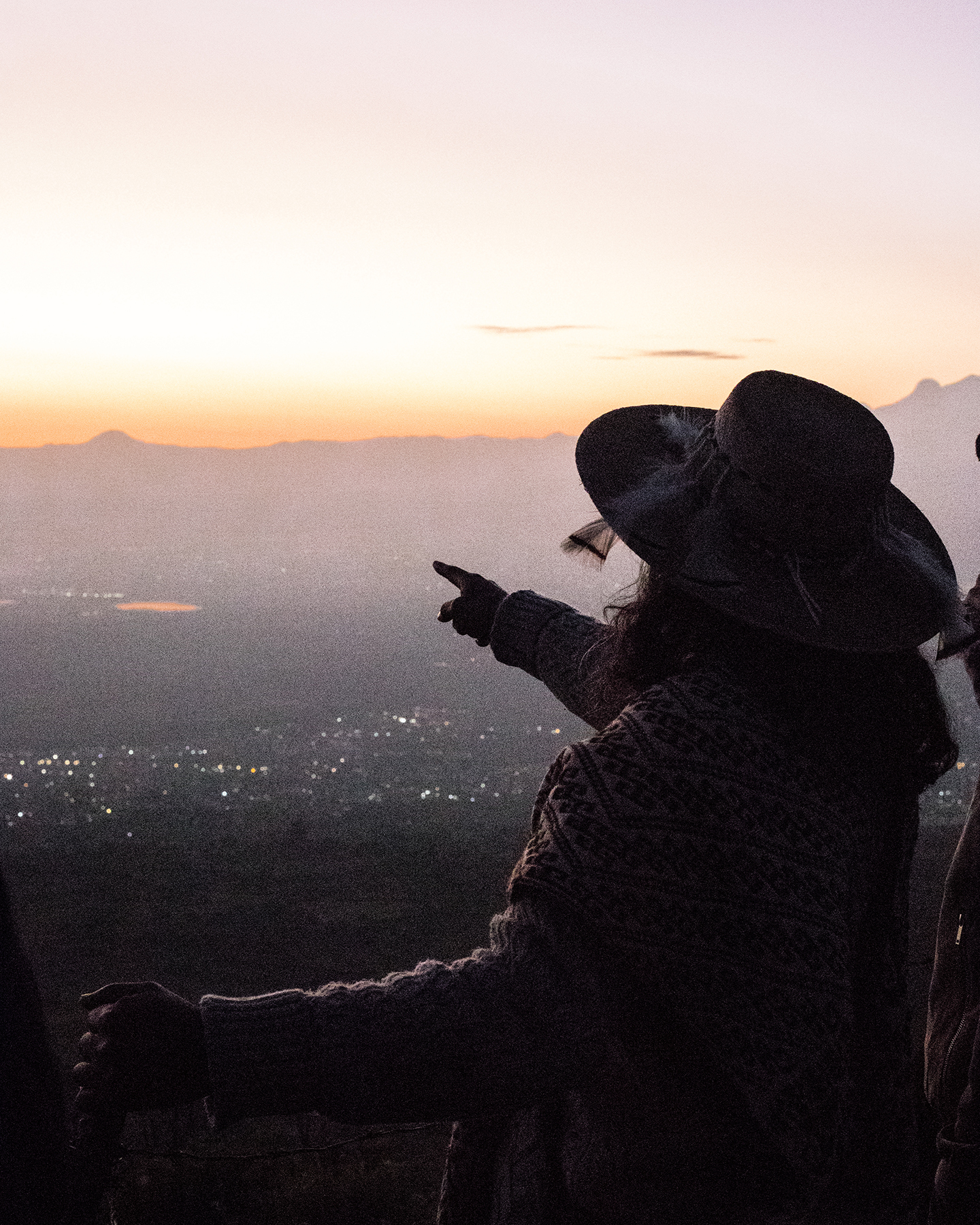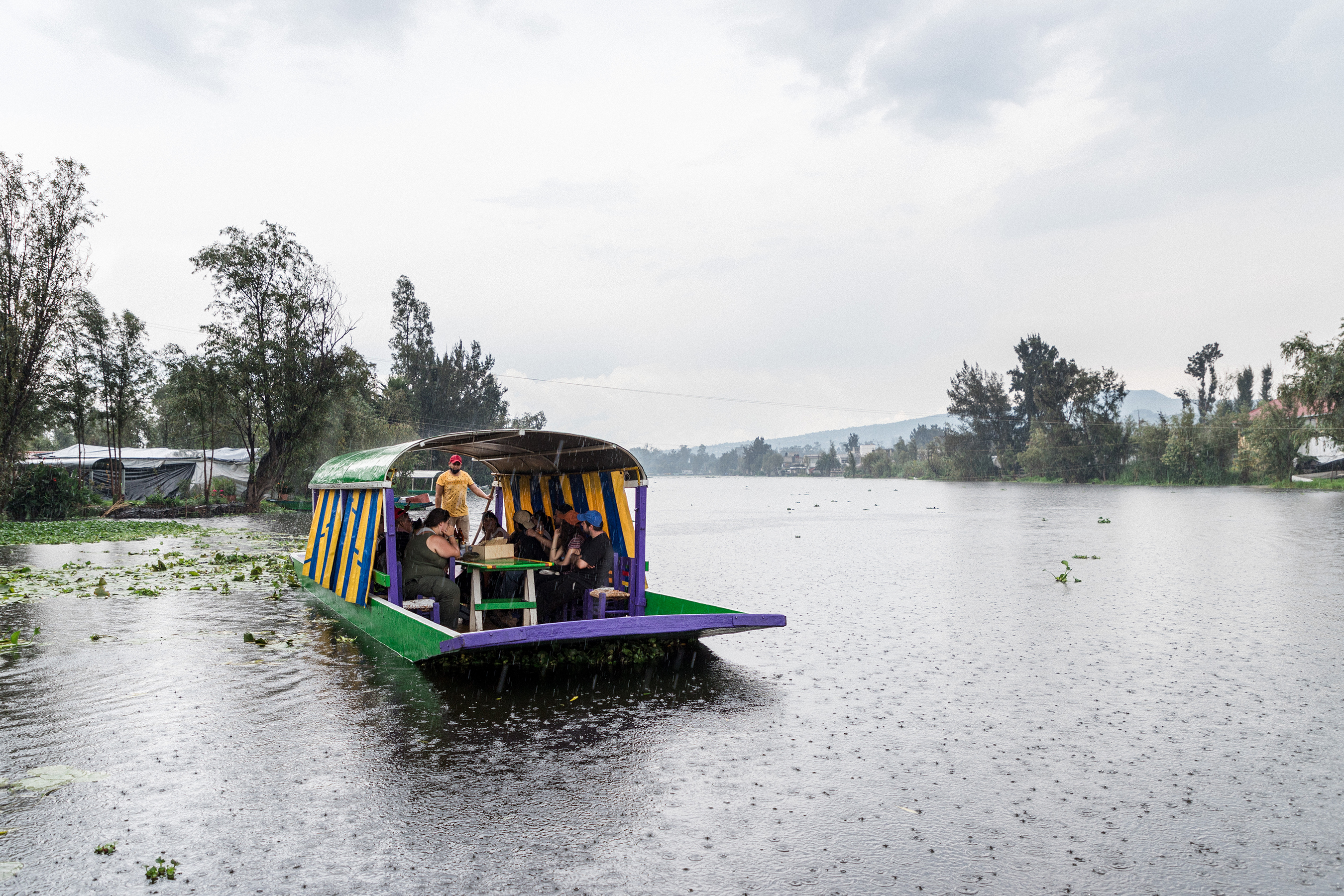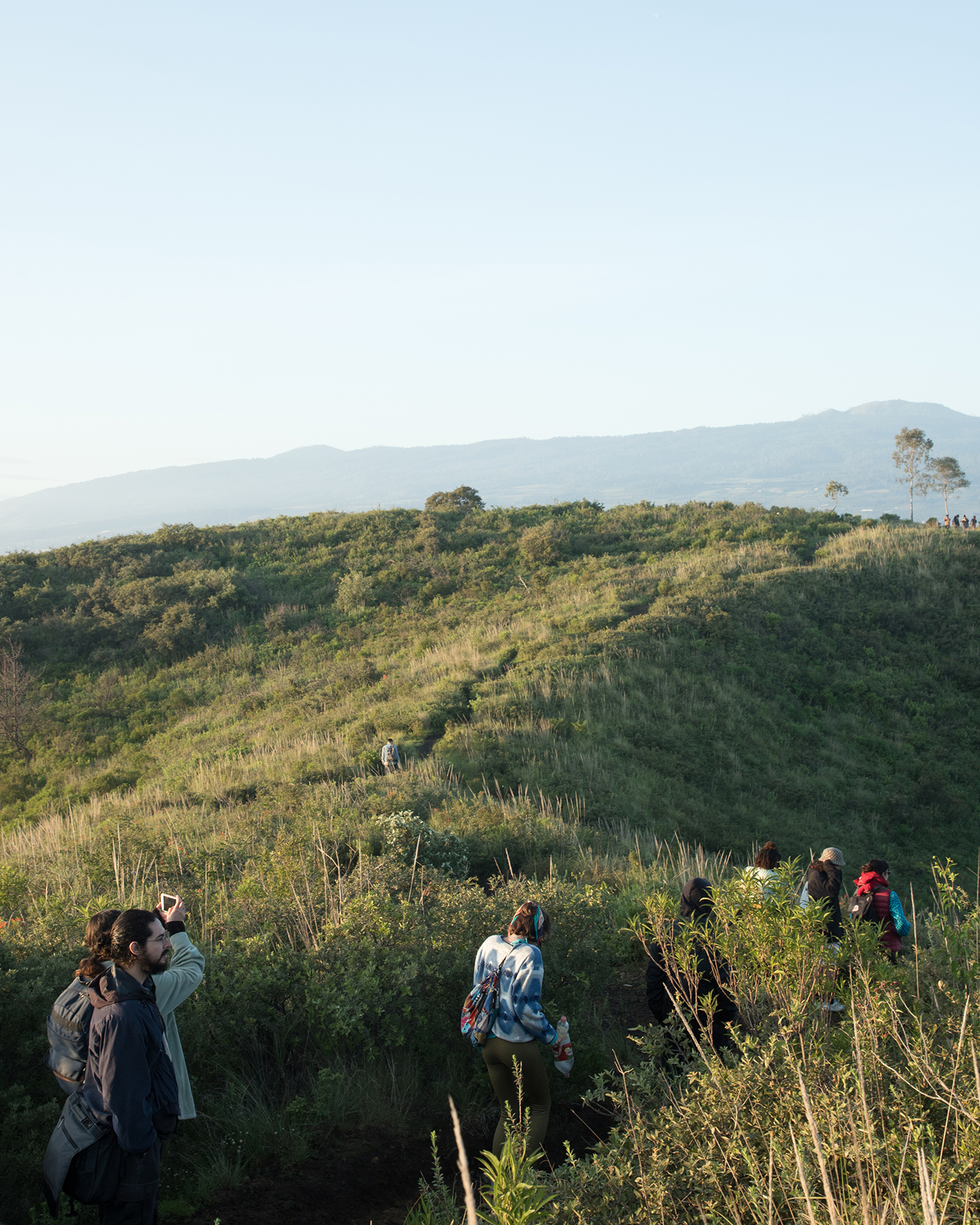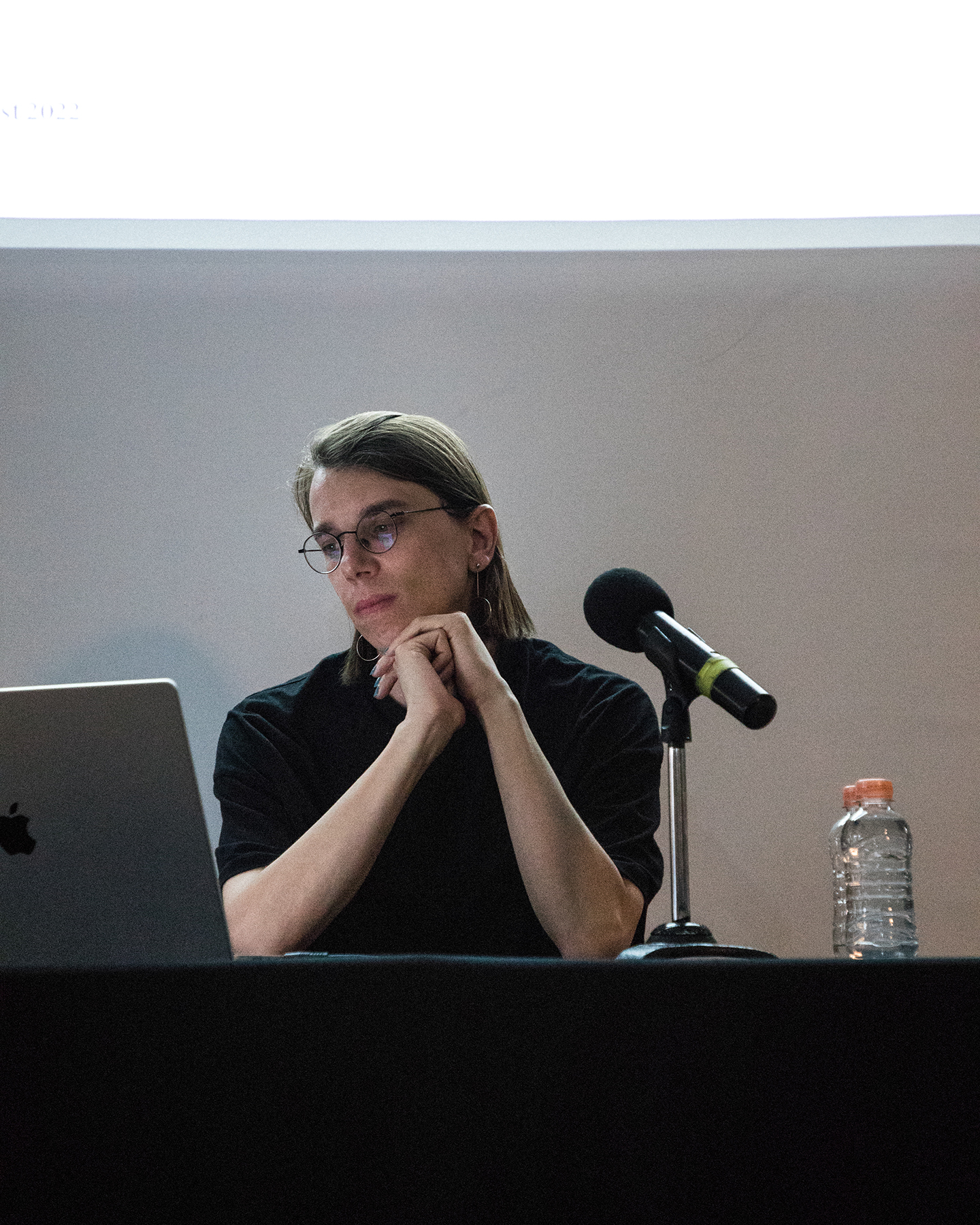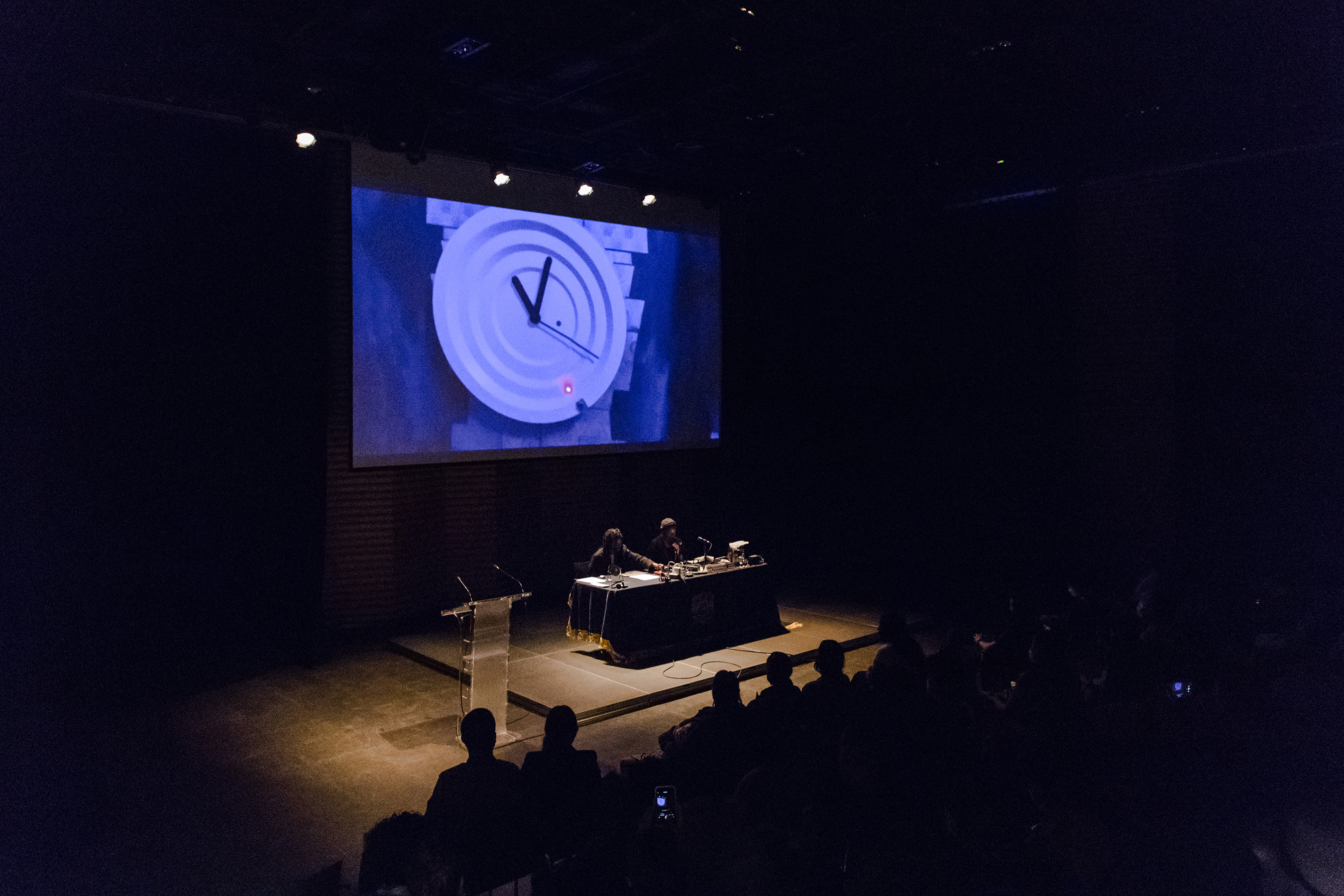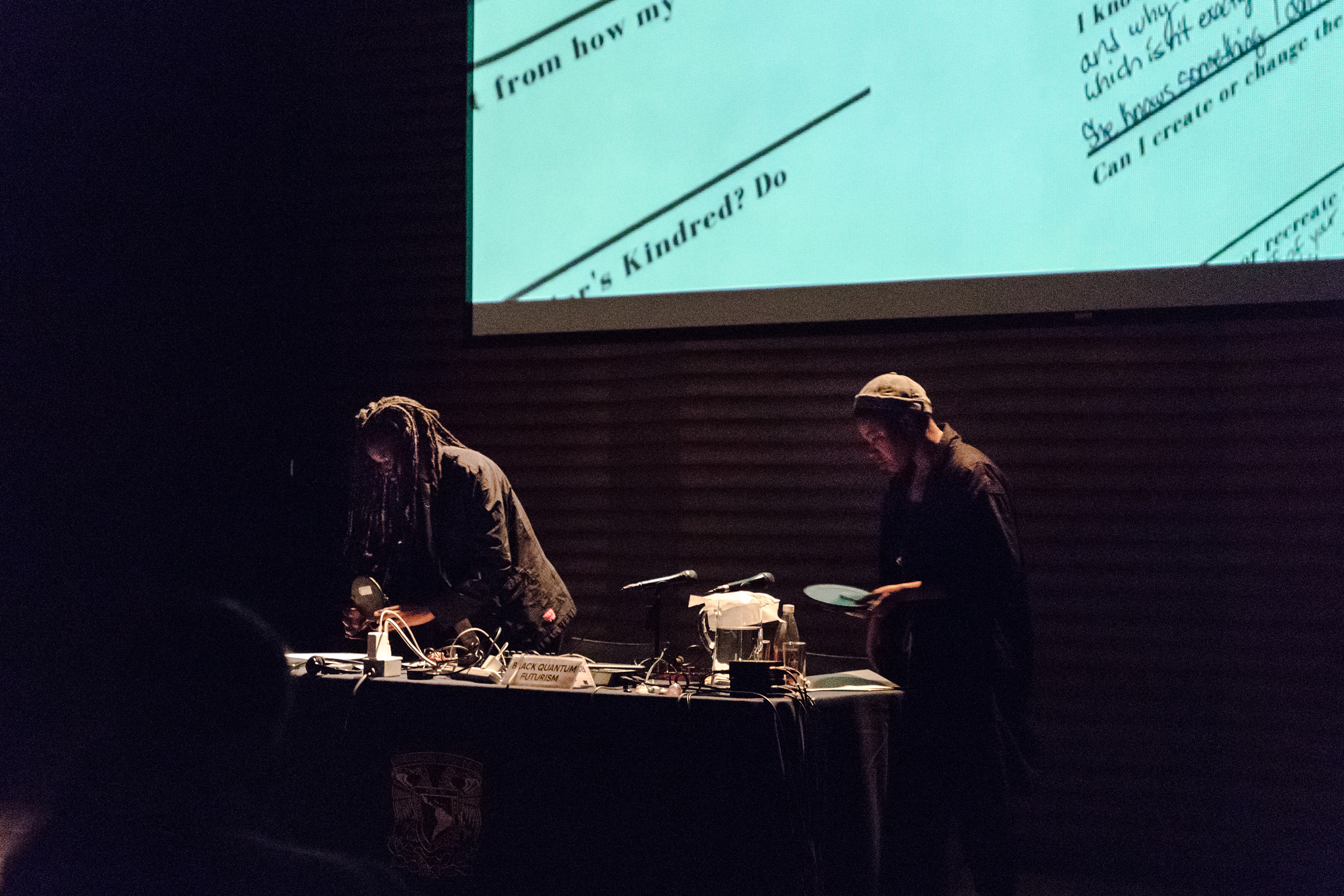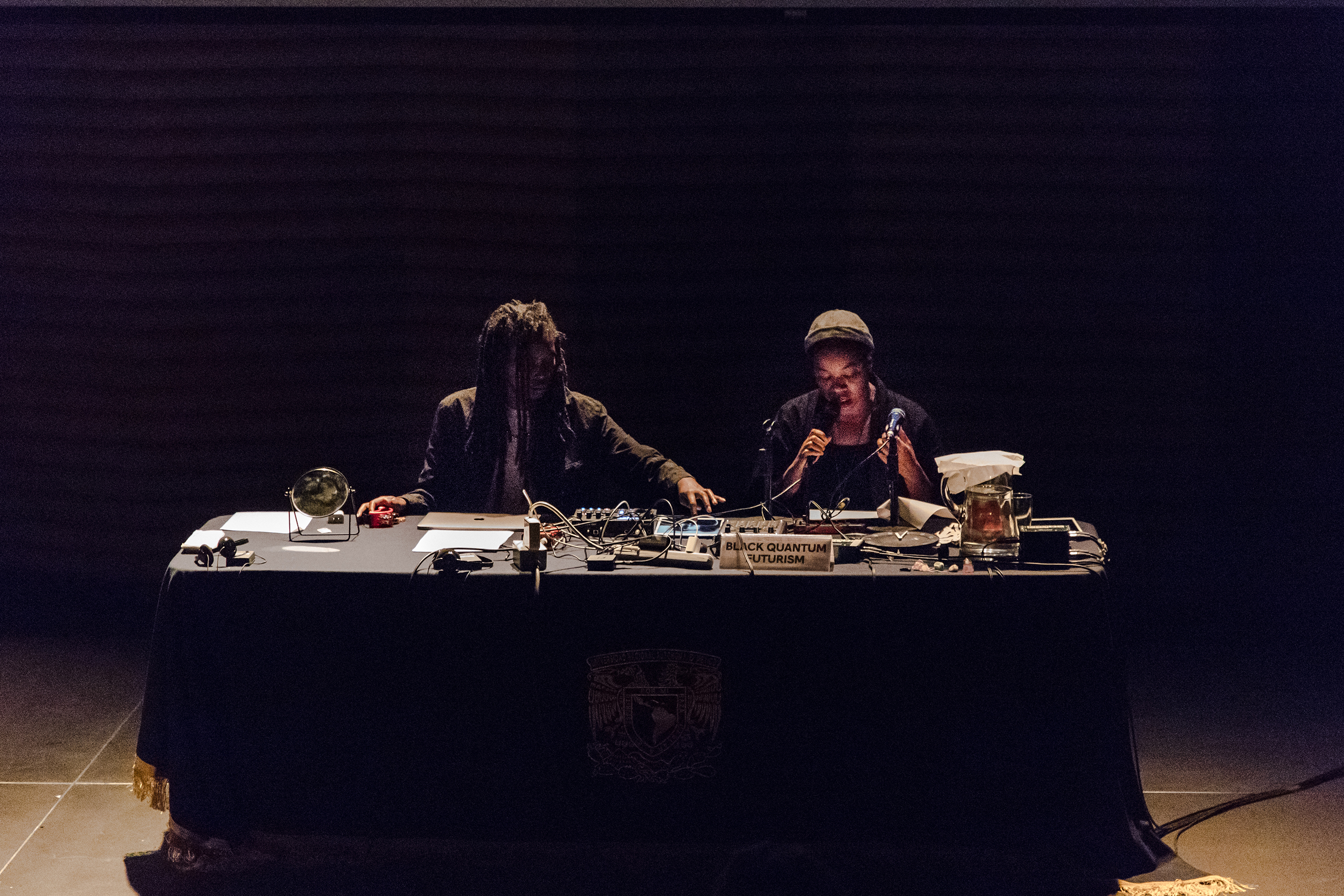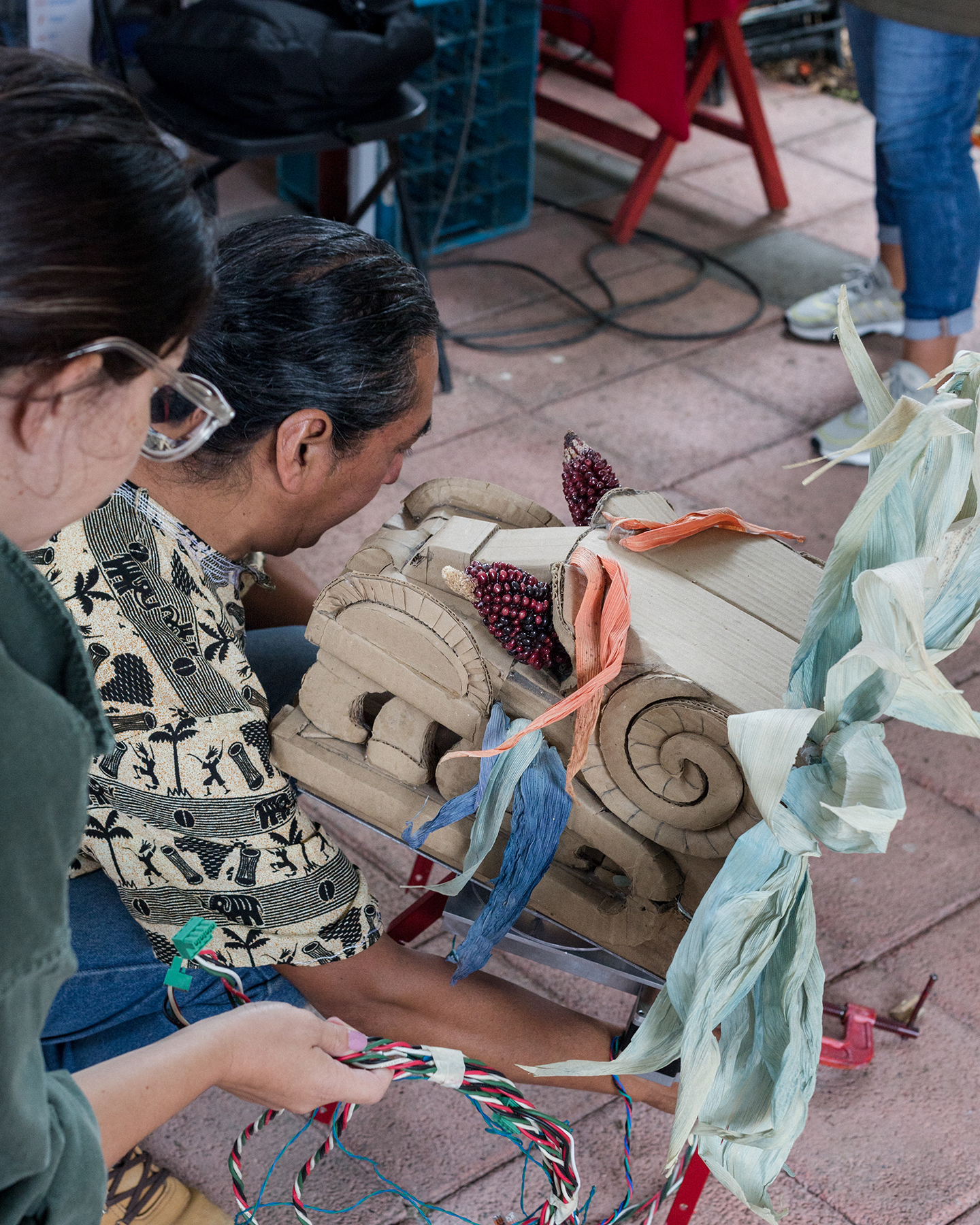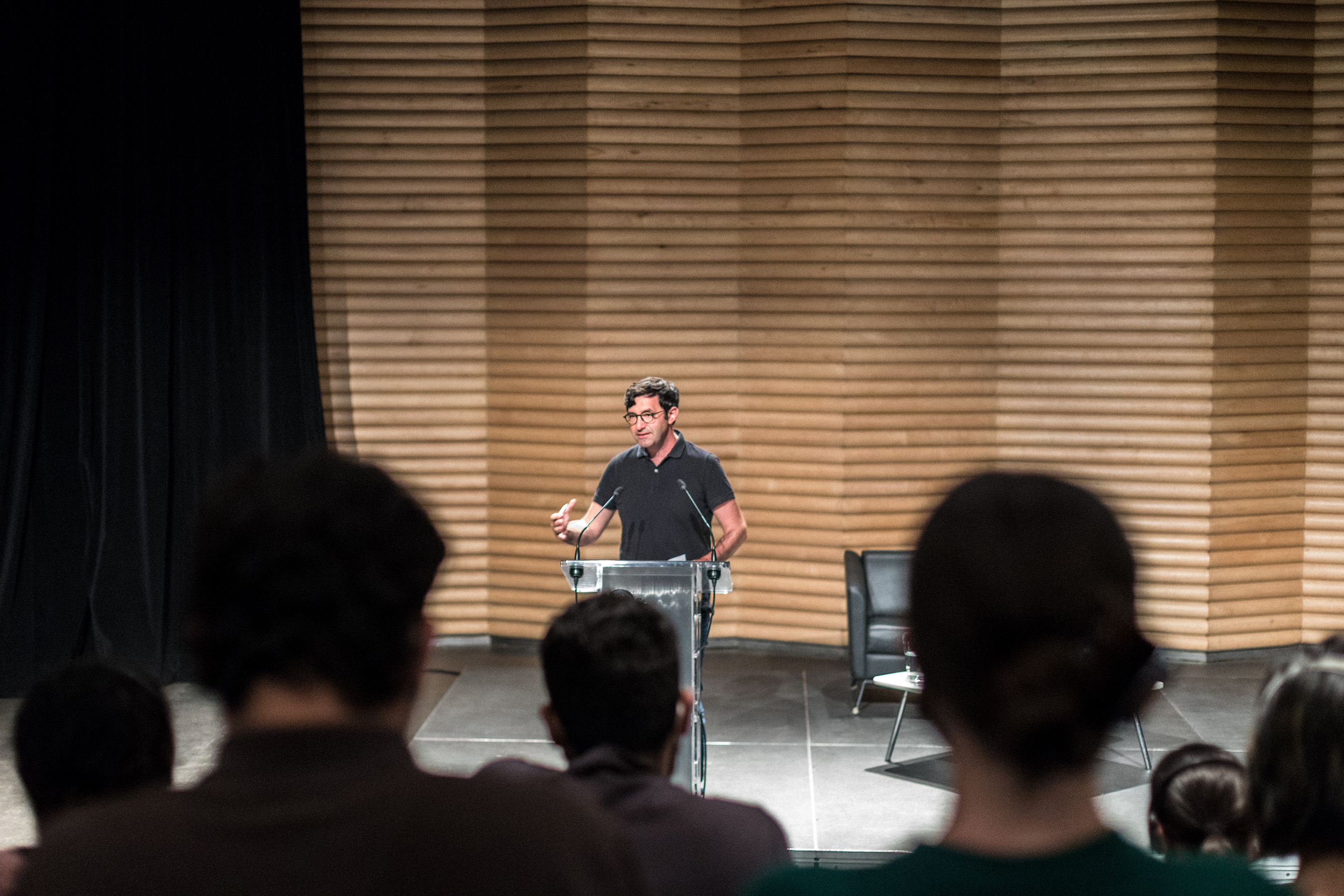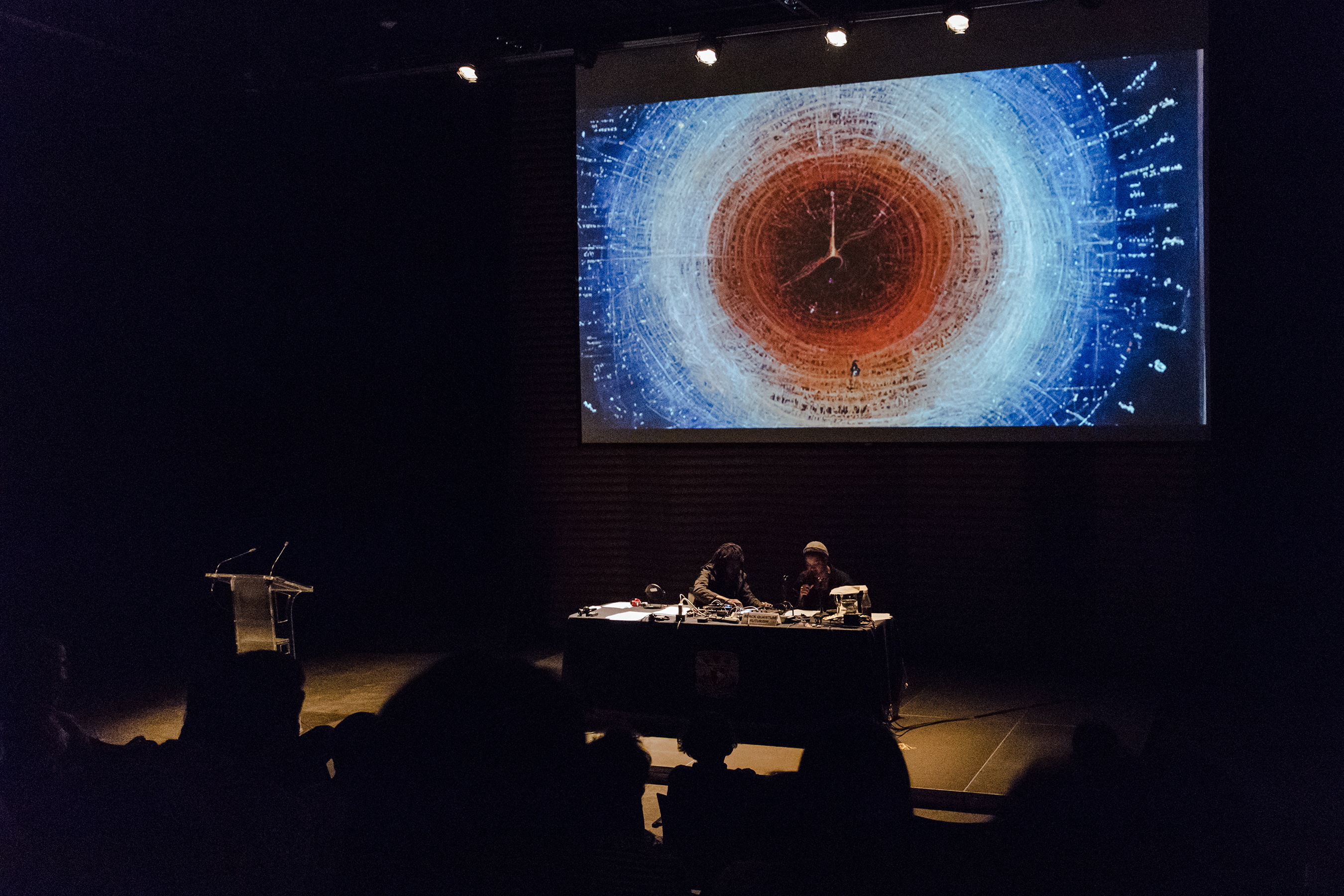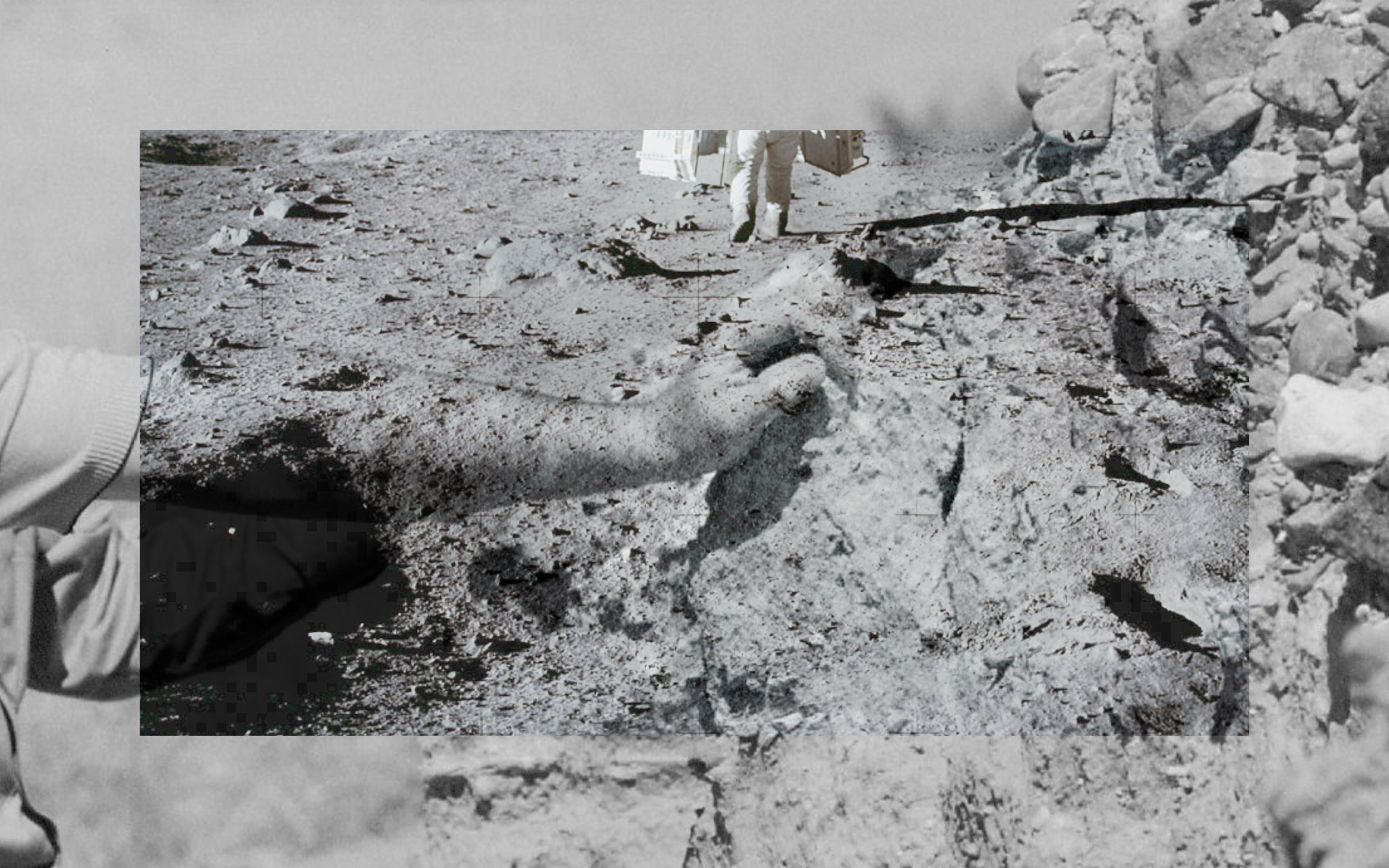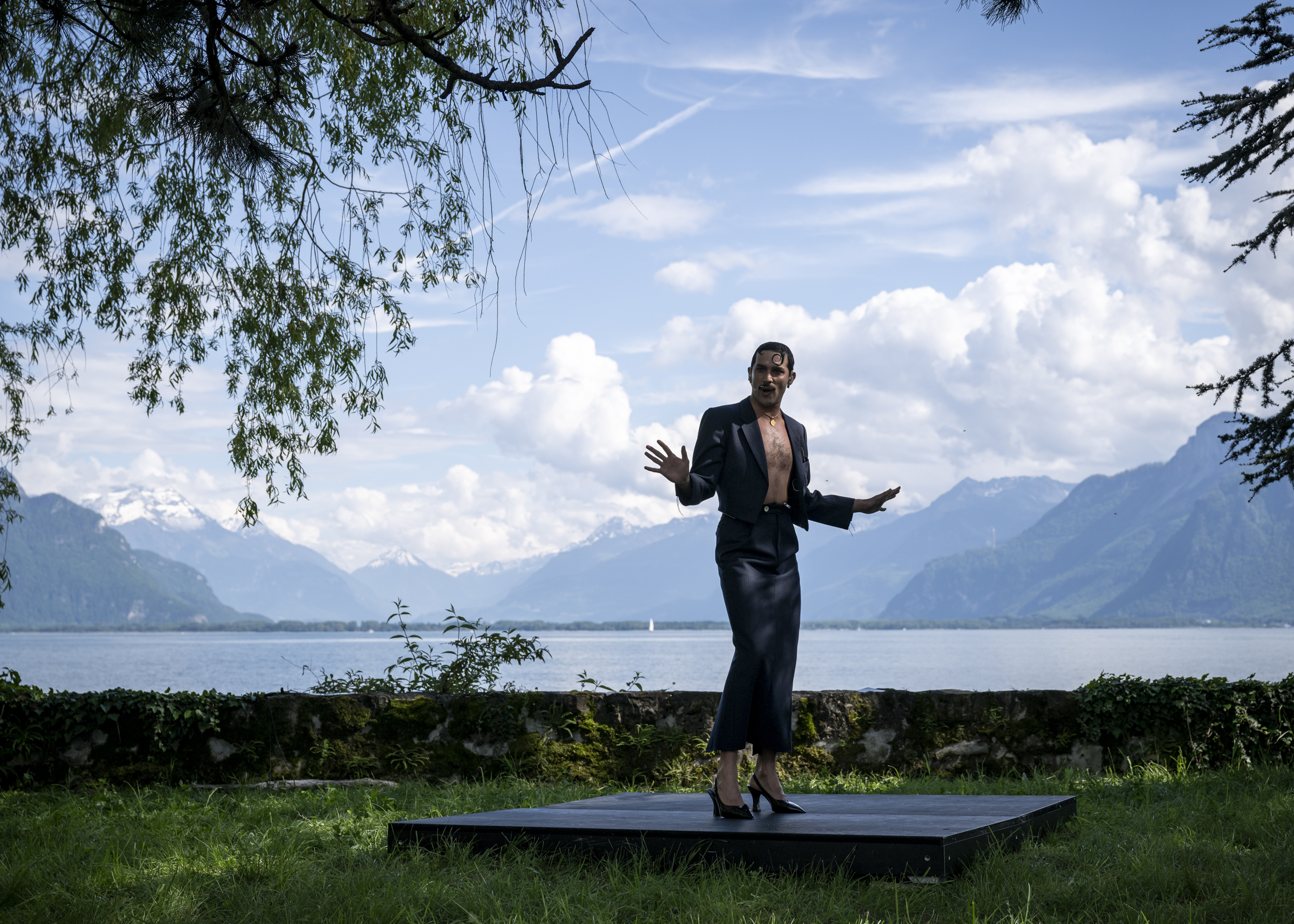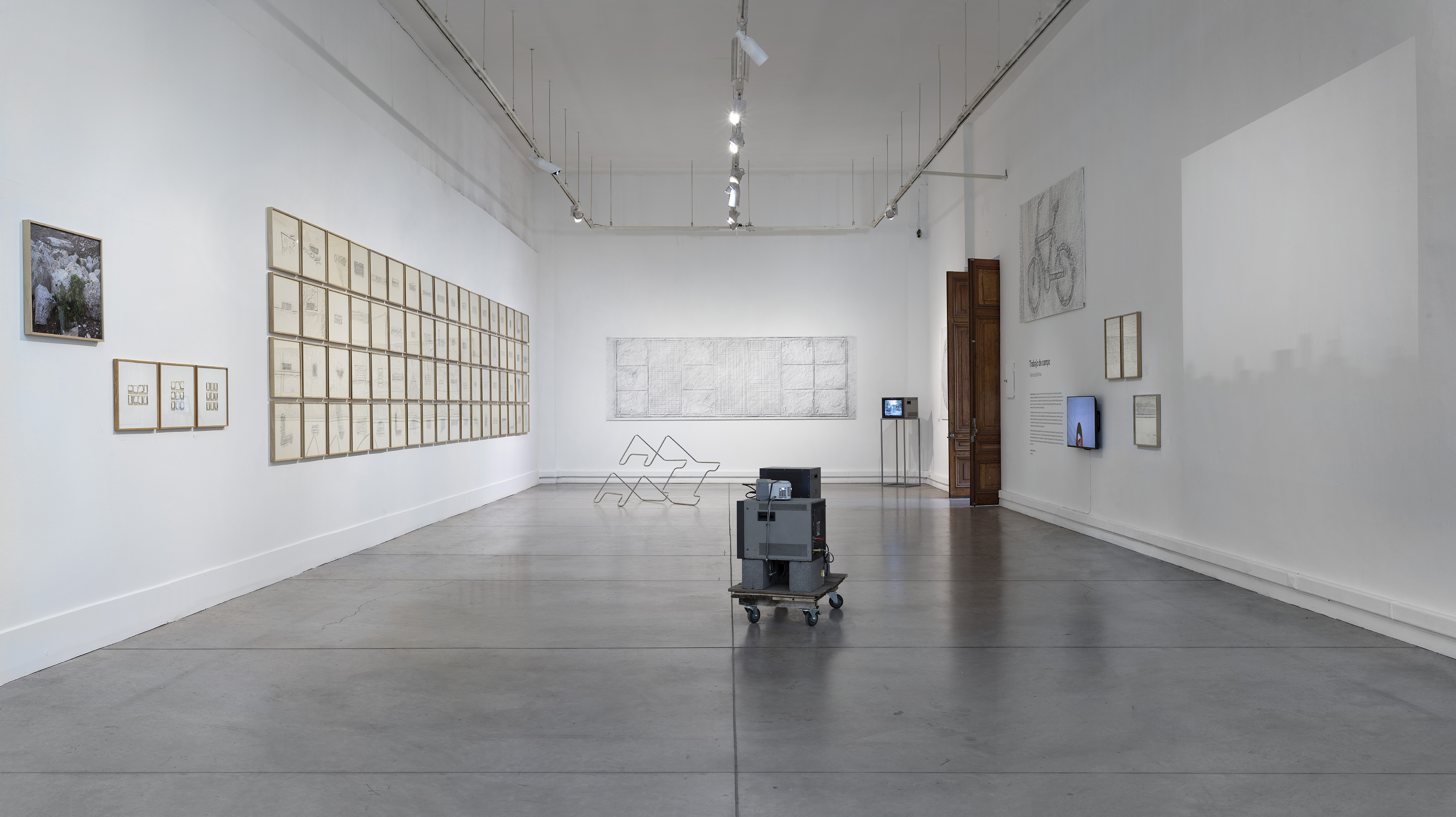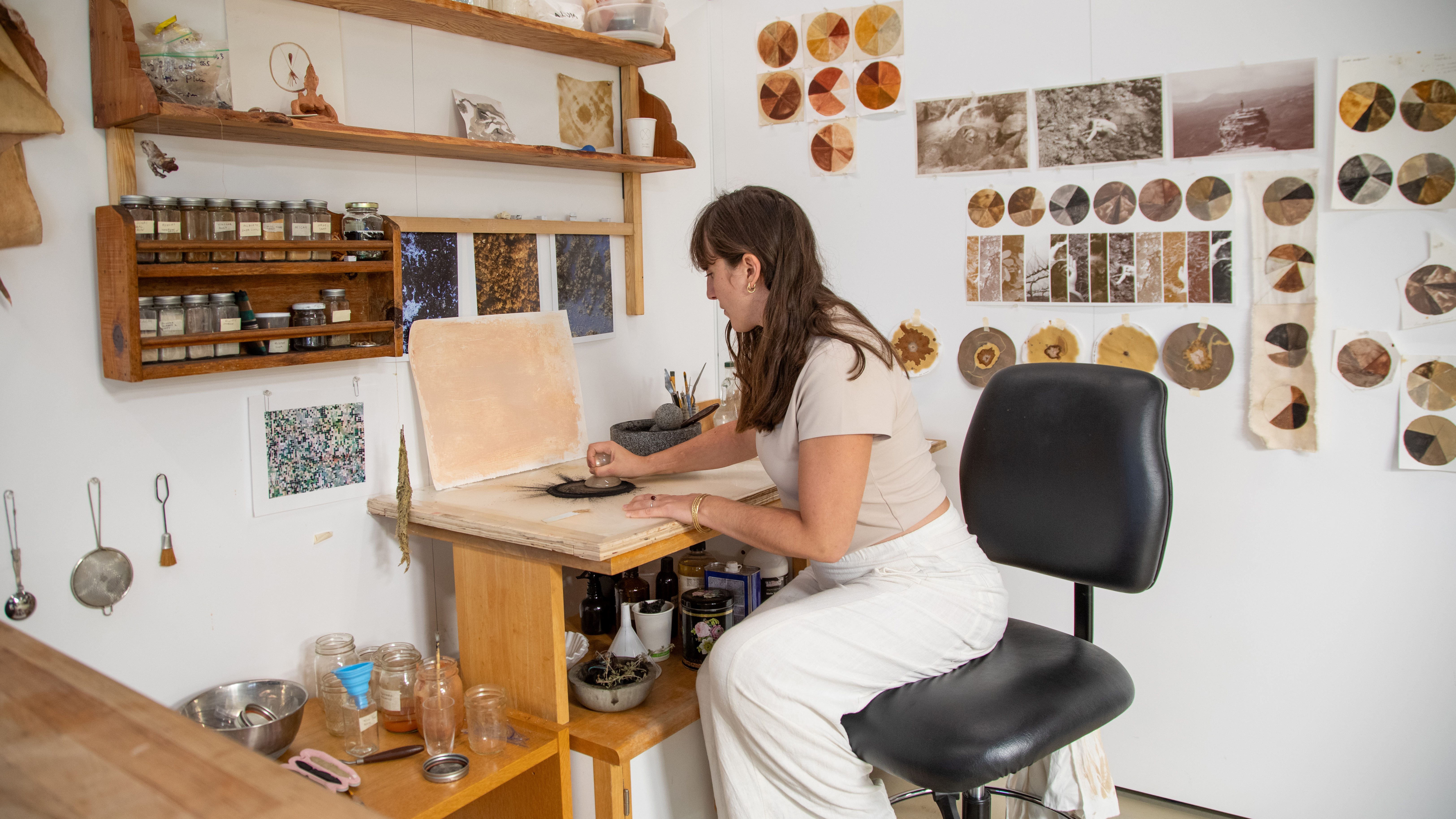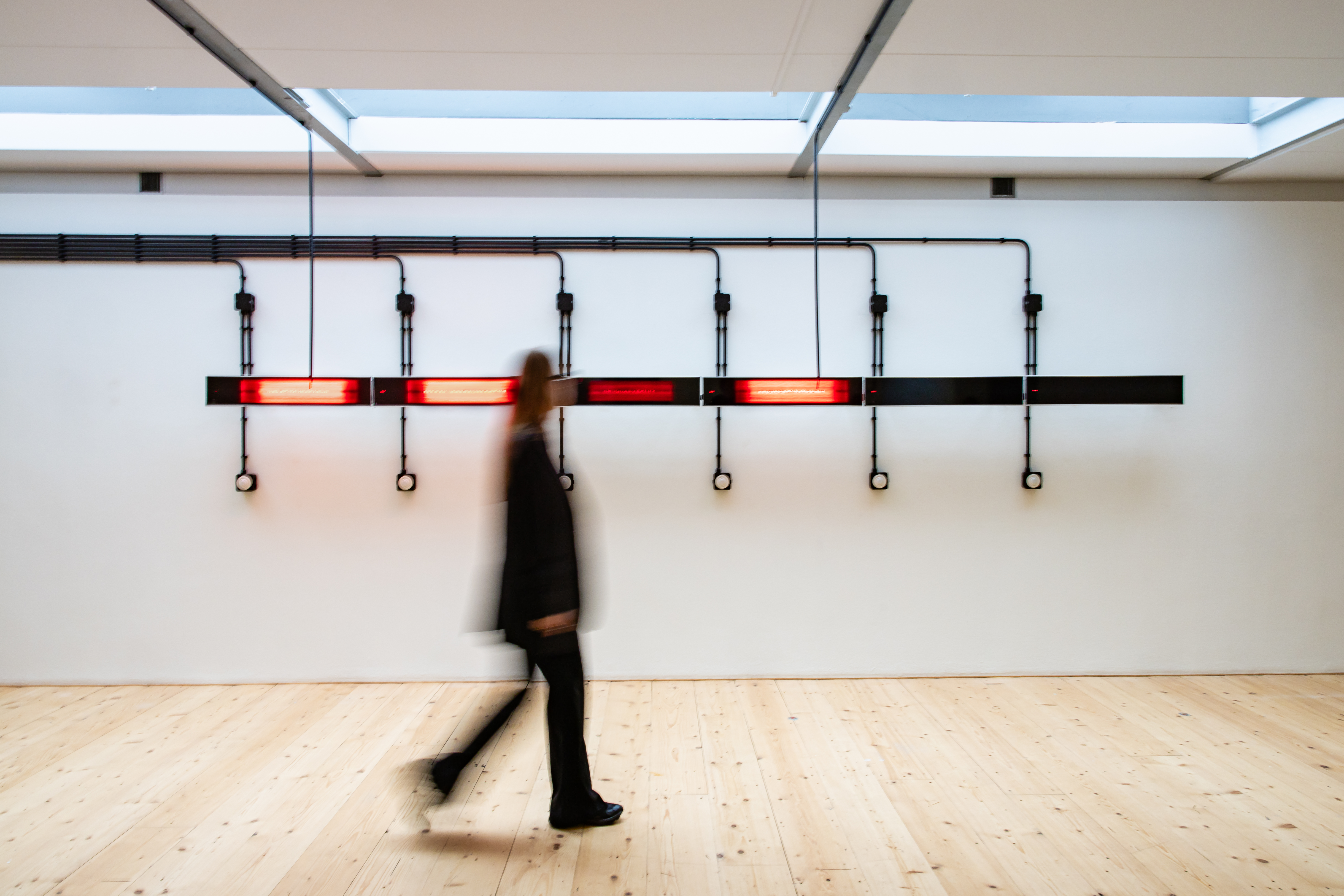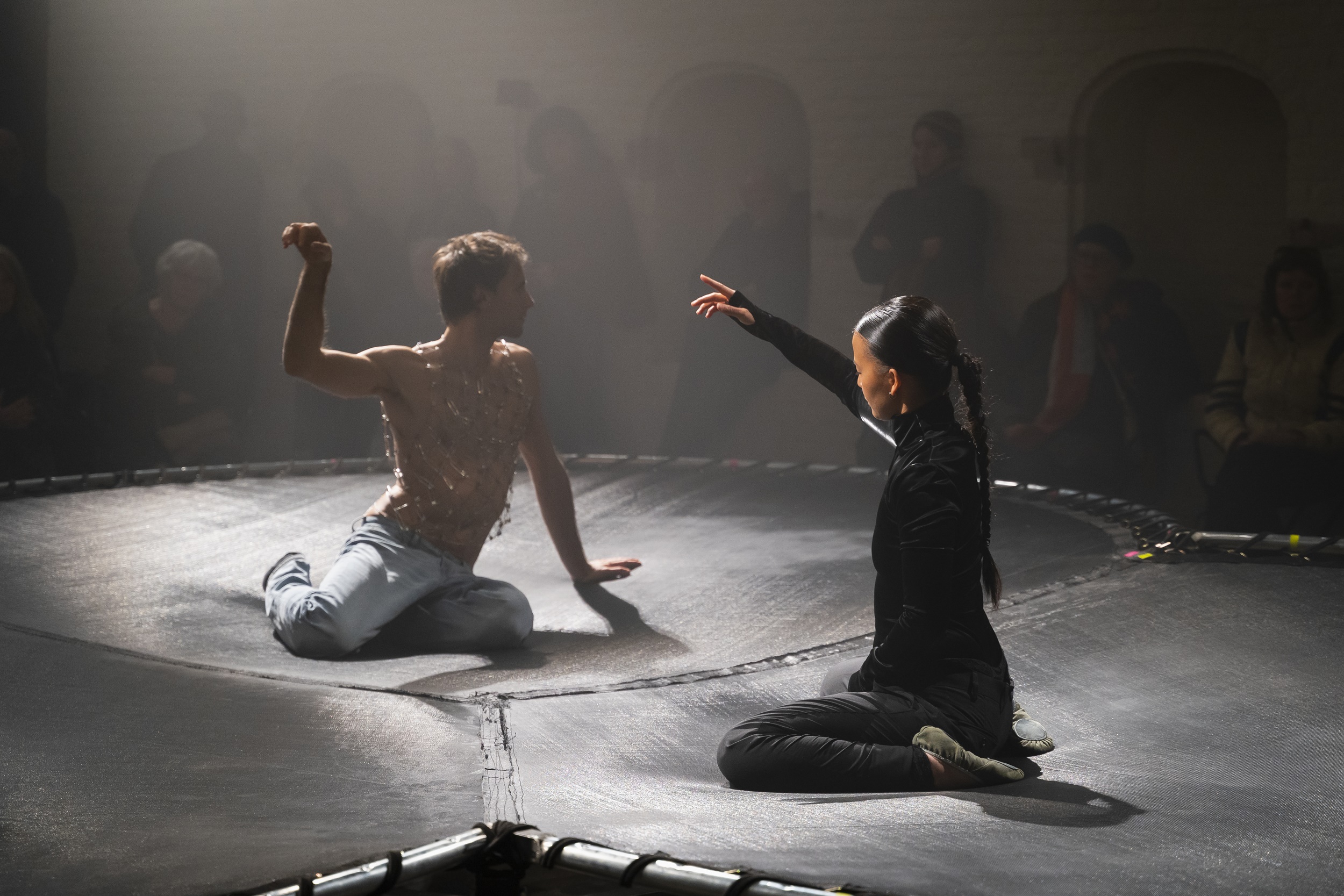“The Rise of the Coyote,” the third edition of Materia Abierta’s summer school, was held in Mexico City in August. Curated by Sara Garzón, the program brought together international and local artists and collectives such as Pedro Neves Marques, Michael Marder, Paula Gaetano Adi, Chakanetsa Mavhunga, Black Quantum Futurism, Fernando Palma Rodríguez, Calpulli Tecalco, Laboratorio Lacustre, and Mujeres de la Tierra to articulate an array of situated, social, and political knowledges. [footnote The plural form “knowledges” appears in the original Spanish text and comes from a conceptual specificity rather than a mere grammatical one. —Trans.] Reflecting on non-Western technologies, organic intelligence, and Indigenous conceptions of the future, “The Rise of the Coyote” took place mainly in the south of Mexico City, in rural or semi-rural districts such as Milpa Alta and Xochimilco, with additional lectures and discussions at Casa del Lago UNAM and Museo Universitario Arte Contemporáneo (MUAC). The following is a free chronicle of the monthlong gathering.
I
It is six in the morning and a group of about forty of us is trudging up the slopes of the volcano Teuhtli, between Xochimilco and Milpa Alta. There is a strange haste, in this place and at this hour, to reach the summit, as if we were late for a work meeting rather than here, out in the open, at 2,710 meters above sea level, struggling to keep our balance on the irregular surfaces of volcanic rock. Our legs have become eyes so to apprehend with each step what objects to avoid: a rock, a trunk of a tree, a maguey, a piece of excrement. Our phone flashlights are not enough to light our path, but they create a subtle spectacle, a small cluster of Wi-Fi-enabled fireflies. Someone, distracted by them, now wears a cut on their leg. Our rush up Teuhtli continues: it began a few hours earlier with arrangements to travel to the community center Calpulli Tecalco, more than forty kilometers from downtown Mexico City, to meet artist Fernando Palma Rodríguez, our guide for this first part of the tour. We are approaching the summit of the Venerable Lord (teuhtli in Nahuatl) when Fernando explains that if we reach it a few minutes before sunrise, we will witness an unusual phenomenon, a kind of negative sunrise in which, strictly speaking, the city is not brought to light by dawn but rather disappears under a chemical haze as its electric lights darken. We will not glimpse the tallest buildings, nor a recognizable urban outline, nor even the gray splatter of the metropolitan area of what was once the largest city in the world and which has since spread beyond its administrative limits. We are not Caspar David Friedrich’s walkers on the sea of clouds, as the urban scene before us lacks the kind of clarity that would allow us to contemplate its totality. A dawn is a birth, an origin—orto in Spanish, related to the Latin words orior, to be born, or origo, origin—but this dark dawn will shed light on a sea of polluted clouds, the smog that turns the daybreak into a non-origin.
We get to the top and, with the sound of rockets, roosters, and the murmur of the group, the sun’s first rays emerge from behind the Trans-Mexican Volcanic Belt. Lest there be any doubt about the historic moment in which we find ourselves, we note that Iztaccíhuatl and Popocatépetl, the iconic snow-capped volcanoes of the Valley of Mexico, do not have a single white spot. Perhaps they never will again. Fernando’s anthropocenic promise is fulfilled: the city disappears in what resembles a sleight of hand by the artist, a magician’s trick that hides the city’s elephantine demographic explosion under the cloak of smog. The Venerable Lord has played a joke on us. The question is not if it is funny but if we can draw at least some lesson from it. This is more radical than it seems: if we think deeply, the question is whether it is still feasible to propose an order of knowledge from this reality, whether a pedagogy can arise from disaster. Those of us who live in Mexico City sigh in despair and, after a brief stop at the crosses that welcome the inhabitants of Milpa Alta every May 3, the Day of the Holy Cross, we go back down the road etched into the volcano. Except for Fernando, who gracefully surfs the volcanic rocks, every one of us slips down the mountainside of Teuhtli, falling over and over and over again.

Visit to Teuhtli, Milpa Alta, Mexico City, with Fernando Palma Rodríguez, August 6, 2022. Photo: Enrique R. Aguilar.
II
When visiting Mexico City, it is difficult to understand that more than half of its land is considered rural, either for “agricultural” or “conservation” purposes, as is officially stated. Corn, amaranth, nopal, maguey, and fodder oats are produced in considerable quantities in the agricultural delegaciones in the south of the metropolis: Milpa Alta, Tlalpan, Xochimilco, Tláhuac, and Magdalena Contreras. The capital is also home to a planted area of some 370 hectares of fruit trees and, although threatened, still preserves some 189 kilometers of canals in the Xochimilco chinampera agricultural zone, of which only fourteen kilometers are used for tourism. [footnote Chinampas are artificial, floating plots of arable land built on freshwater bodies. Of Mesoamerican origin, their use is still active in the southern wetlands of Mexico City. —Trans.] If one looks at a map of the city, the division between urban and rural is even more radical and, therefore, its effect is even stranger: the city’s territory is divided in half, and entire delegaciones are colored green against the grayish areas of the north and center, where the architectural or urban icons of the Mexican metropolis lie. I call it a strange effect because it is part truth and part trick. It is true that the dynamics of Mexico City often disregard those areas of the city that do not concentrate capital like the rural ones (i.e., there is no easy access to Xochimilco or Milpa Alta by public transportation, and the subway line that finally reached Tláhuac after decades of neglect collapsed in May 2021, leaving behind twenty-six dead). The tricky part, however, is that this divide could easily foster the assumption that the rural areas’ abandonment would turn them into territories of symmetrical opposition to the “official” Mexico City. Instead, metropolitan dynamics overdetermine the territory not only of the capital’s districts but of the entire region of the so-called Metropolitan Area of the Valley of Mexico, with its twenty-two million inhabitants. “The Rise of the Coyote” assumed the difficult task of reimagining these dynamics, however possible that might be.
Fernando’s act of prestidigitation at Teuhtli illustrates precisely this: the modern separation between countryside and city, typical of the bourgeois era, is no longer operative even if we unconsciously continue to reproduce it. Ecuadorian Marxist thinker Bolívar Echeverría taught us Latin Americans this fact years ago: the countryside has been definitively subordinated to the big city and has become a mere appendage of its industrial periphery. Nature as such no longer exists, and this new urban entity, he asserted in 1989, is still awaiting to be theorized. I do not know if we Mexicans or Latin Americans have been up to this theoretical challenge, but at least we can now take up one of its main threads through Echeverría’s concept of technological rent. According to him, a key part of the fading of nature occurred when the “lords of the land,” those landowners who demanded payment for the use of especially productive land, gave way to the “lords of technology,” “those who demand payment for the use of certain production procedures elaborated especially in technical terms.” [footnote Bolívar Echeverría, Modelos elementales de la oposición campo-ciudad (Mexico City: Itaca, 2013), 81–82.] This theoretical point is key to understanding the explosion of these “Latin American monstrous post-urban conglomerates,” such as São Paulo, Lima, or what at the time of Echeverría’s writing was still called the Mexican Federal District. With an ironic edge, Echeverría exemplifies the notion of technological rent when he talks about how, starting in the 1970s, the use of trucks for banana transport in so-called “banana republics” became more expensive than the bananas themselves. I make this brief theoretical detour because of its importance for understanding not only the concept of nature but its interrelation with the idea of technology, which was central to the Materia Abierta program in 2022. That is to say, if one wants to speak seriously of non-Western or Indigenous technologies, it must be done in light of the kind of subsumption that technological rent enforces: in this case, if half the territory of Mexico City is still considered rural, agricultural, or conservational, it is only nominally so, within a broader playing field that defines and determines its modes of production. Concepts such as technological rent allow a type of articulation that is no longer just aesthetic but economic and political as well, making possible a deeper social transformation. Its habitual absence in artistic fields and in pedagogical programs like Materia Abierta, among others, can be understood as a symptom of a soft and almost symbolic kind of politicization of these spheres.
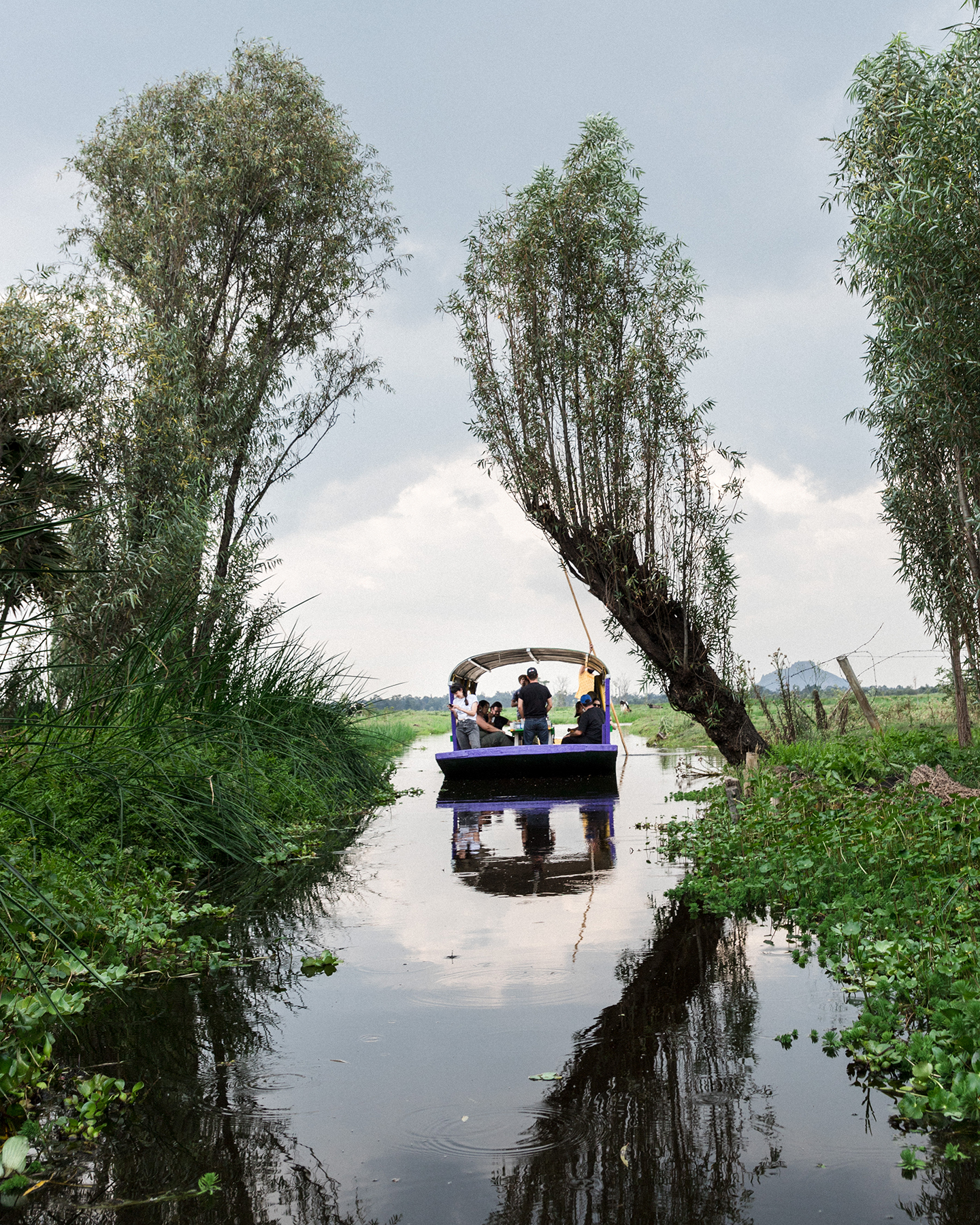
Ciénega de San Gregorio Atlapulco, Xochimilco, August 13, 2022. Photo: Enrique R. Aguilar.
III
While passing through one of the canals in the non-touristic agricultural area of Xochimilco, a rainstorm begins to fall and forces us to stop our journey for half an hour. And even if we are not tourists (though aren’t we? an uncomfortable yet pertinent question), we must acknowledge that the farmers in the area are wary of the typical behavior of these unwanted visitors and may ask us to leave at any time. In recent decades, Xochimilco has been retooled as a mere place of recreation for outsiders, but historically its presence in modern Mexico has been more profound, complex, and problematic: it has represented an ideal scenario in the construction of a bucolic imaginary that engages a longing for the pre-Hispanic past of the city. If this is what this territory was like, it is often said, if the harmonious balance between nature and technology represented by the chinampa was once possible, if this agricultural technique guarantees food sustainability, then for the possible future city we must, first of all, defend what remains of it and, second, follow its lead and relate to nature in a different way. The torrential rain that stopped us allows, between beers, for these meditations and a little more to emerge from our group: there is something in the floating cadence of a trajinera on the water, in its leisurely drift, in the absence of other visitors, in the contemplation of a cow or a bird getting soaked, there is something, in short, in the foggy edges between the liquid and the terrestrial, that makes the imagination soar. [footnote Trajineras are traditional flat-bottomed boats designed to navigate through the canals of the chinampera areas. —Trans.] Suddenly we find ourselves talking about other experiences, a trip to a mountain, to a cave, to a sacred place, where the borders between reality and the hallucinatory were also blurred. I don’t believe in ghosts, but …
In Water and Dreams (1942), Gaston Bachelard writes that the eye tires of the solid, that it yearns to dream of deformation, and that meditating on a particular kind of matter informs an open imagination. [footnote Gaston Bachelard, El agua y los sueños: Ensayo sobre la imaginación de la materia (Mexico City: FCE, 1978), 11.] In Xochimilco, in this case, water is the pedagogue of the diffuse. It opens up thought and almost makes us levitate above the solidity of the world. This is a state as fascinating as it is dangerous: it can lead us to the edge of the ahistorical and therefore of the apolitical. This levitation allows a kind of speculation that is not determined by the material references of the world, a sort of fantasy that flies over history and its political limits. From there, for example, it is easy to redraw the separation between the urban and the natural, and I think that this is why Xochimilco has served as an image for the nostalgic idealizations of premodern Mexico. If in doubt, turn to María Candelaria, the 1943 film directed by Emilio Fernández—originally titled Xochimilco— and to its fantasy of a nonhistorical indigenism, symbolized by the actress Dolores del Río. Her simple life, of genuine love and honest work, is fractured by Damián, a mestizo shopkeeper in love with her, with whom she incurs a debt. Symptomatically, the shopkeeper becomes no longer willing to accept vegetables or flowers to cover the debt and wants money. María Candelaria is a kind of pure, precapitalist, Indigenous presence, and so is Xochimilco. The rest of her town, however, is truly Indigenous (or, for that matter, contemporary Mexican): it is distrustful, superstitious, prejudiced, narrow-minded. María Candelaria is “an Indian of pure Mexican race” who has “the beauty of the ancient princesses that the conquistadors came to subjugate,” to quote the old artist who serves as the film’s first narrator, and tragically she is killed by “those of her own race,” those who “always kept her isolated like a harmful animal.” The film seems to anticipate contemporary projections about Xochimilco.
The political history of the region is, of course, far more complex and, as I have noted, does not allow for a simple separation between the purity of the natural and the malignity of the technological. In the dreamy state of the trajinera it is easy to forget that those of Xochimilco are also technical waters, as we could call them: in order for the canals to maintain their water level it is necessary to supply them with water from the Cerro de la Estrella Wastewater Treatment Plant in Iztapalapa, in quantities that can amount to more than fifty-eight million liters of treated water per day. The aquifers beneath Xochimilco have been intensively exploited since the Porfiriato—the same period in which María Candelaria is set, curiously enough—and this emergency solution has been reached through overdetermination; the technological rent, in this case, is collected by the state.
IV
If a pedagogical program of the likes of Materia Abierta is useful for current political discussions, it is to the extent that its results manage to penetrate the dynamics of the contemporary metropolis, as described by Bolívar Echeverría. If “the rise of the coyote” implies a return to the Earth, that return will be useful only if it does not turn into a symmetrical opposition to the technical, fetishize the Indigenous community through unproblematized conviviality, or transform the nonhuman into a reservoir, even a moral one, of interaction with the environment. These are problems that the Materia Abierta program could continue to explore with even more depth and articulate more explicitly, although curators like Sara Garzón and artists like Fernando Palma Rodríguez did so implicitly when they brought us face-to-face with the environmental moment of the Mexican metropolis. Michael Marder, notably, engaged them through his concept of the dump. His lecture for Materia Abierta presented an outline of a possible vegetal policy and had a curious hint of hope, especially when contrasted with the crushing diagnosis he presents in Dump Philosophy. [footnote Michael Marder, Dump Philosophy: A Phenomenology of Devastation (London: Bloomsbury, 2020).] In his lecture, Marder revisited the overdetermination of the capitalist city on the rural territory from another angle: if the divide between city and countryside is no longer possible (a divide between a sphere already affected by industry, violence, or capital and an intact sphere to be preserved and defended), neither is the distinction between the body’s interior and exterior or between body and soul. The landfill, in the form of toxins or microplastics and the pervasiveness of the waste it produces and expels, is so profoundly inside of us that our ideas, too, are ideas of the dump. Not that our ideas are identical to the dump, but rather that they inevitably arise from the dump’s particular maelstrom so that its taint is indelible. Marder put this forward with a kind, good-natured face, almost smiling, in contrast to the seriousness of his statements. Pedro Neves Marques offered something similar in their first session of the summer school: it is no longer possible to separate the idea of nature from industrial chemicals. Marder might add: it is no longer possible to separate any idea from those chemicals. Therefore, the question posed at the beginning of this text about the ordering of knowledge, about a pedagogy from disaster, is a radical one: it implies the construction of a cognitive scheme that can buy us some time in the face of the dynamics of the maelstrom and the fall of the dump.
Torrential rain pours down on Xochimilco and, from our (non-)touristic trajineras, while recording beautiful videos for Instagram, we are already planning to go for a pulque in a nearby cantina or to go dancing. Drunkenness, it is known, can also encourage an open imagination and incite dreams of deformation. It rains, and the rain reminds that there can no longer be small talk about the weather: as Neves Marques said in their talk, there is no longer a difference between foreground and background. But even if they were referring to their craft as a filmmaker, what prevents us from using their idea to talk about the environment? “Nature comes to us,” they asserted casually, and such an assertion, in 2022, among a small international group of students, sounds intimidating. I can’t help but think that this same rain is threatening my hometown right now, Tula, in the state of Hidalgo, which last September suffered a flood that left seventeen dead in its wake. The waters that flooded Tula and a large part of the Mezquital Valley were technical waters too: all those waters were drained from Mexico City to prevent it (and only it) from suffering any damage. How can I not decry the pincers of the metropolis, whose grip already surrounds any territory even if it is, as in the case of Tula, more than one hundred kilometers north of the city? How can I not subscribe to Marder’s thesis when I have breathed the black waters of Mexico City for as long as I can remember, even when I did not live here? Incidentally, I think that if Fernando Palma Rodríguez showed us a negative dawn, the waters that irrigate the Mezquital Valley are those of a negative fertility.
Nature comes to us and time is pressing, because time, as Black Quantum Futurism brilliantly taught us at the last Materia Abierta lecture, is also overdetermined by capital. The clock has pincers too, and it stares menacingly into our eyes and sets the pace. We float on mediated waters and hike up an extinct volcano, and we are in a hurry. If in the midst of it all we feel terribly impotent it is because places like Mexico City and the areas it forces into its gravity are some of the many laboratories on the planet where the amount of waste and violence a population can endure are tested. Therefore, these regions can become radical fields for urgent pedagogical questions, if that pedagogy is still possible. This is where programs such as Materia Abierta ought to double down and assert themselves in all their political nature, to delve even deeper into the territoriality that sustains them and articulate with knowledge from disciplines such as political economy and history. From these dark mirrors of the world, and only from them, can another kind of life, or something resembling a rise, a rebellion, be conceived. See you next year.
Translated from the Spanish by Juan Francisco Maldonado.
The plural form “knowledges” appears in the original Spanish text and comes from a conceptual specificity rather than a mere grammatical one. —Trans.
Chinampas are artificial, floating plots of arable land built on freshwater bodies. Of Mesoamerican origin, their use is still active in the southern wetlands of Mexico City. —Trans.
Bolívar Echeverría, Modelos elementales de la oposición campo-ciudad (Mexico City: Itaca, 2013), 81–82.
Trajineras are traditional flat-bottomed boats designed to navigate through the canals of the chinampera areas. —Trans.
Gaston Bachelard, El agua y los sueños: Ensayo sobre la imaginación de la materia (Mexico City: FCE, 1978), 11.
Michael Marder, Dump Philosophy: A Phenomenology of Devastation (London: Bloomsbury, 2020).
